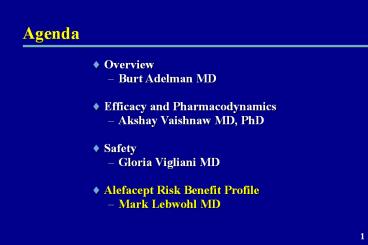Agenda - PowerPoint PPT Presentation
1 / 28
Title:
Agenda
Description:
Non-melanoma skin cancer occurring in patients treated with PUVA five to ten ... arteriolar hyalinosis, focal interstitial fibrosis, sclerotic glomeruli. 17. Baseline ... – PowerPoint PPT presentation
Number of Views:15
Avg rating:3.0/5.0
Title: Agenda
1
Agenda
- Overview
- Burt Adelman MD
- Efficacy and Pharmacodynamics
- Akshay Vaishnaw MD, PhD
- Safety
- Gloria Vigliani MD
- Alefacept Risk Benefit Profile
- Mark Lebwohl MD
2
Psoriasis
3
Psoriasis
4
Psoriasis
5
Psoriasis
6
Psoriasis
7
Alefacept Clinical Trial Patients Baseline
8
Impact of Psoriasis
- Psoriasis causes as much disability as other
major medical diseases (Rapp, Feldman, et. al.,
Journal of the American Academy of Dermatology)
9
Light Therapy Unit
10
Limitations of PUVA
- Non-melanoma skin cancer occurring in patients
treated with PUVA five to ten years after first
treatment (Stern et al., J Invest Dermatol ,
1988) - Malignant melanoma in patients treated for
psoriasis with methoxsalen (psoralen) and
ultraviolet A radiation (PUVA). The PUVA
Follow-Up Study (Stern et al. N Engl J Med 1997)
11
Limitations of Methotrexate
- Complications in methotrexate treatment of
psoriasis with particular reference to liver
fibrosis (Ashton et al., Invest Dermatol, 1982) - Methotrexate in psoriasis consensus conference
(Roenigk HH Jr, Auerbach R, Maibach H, Weinstein
G, Lebwohl M, (J Am Acad Dermatol, 1998) - A 21-year experience with major hemorrhage after
percutaneous liver biopsy (McGill et al.,
Gastroenterology, 1990) - Methotrexate for rheumatoid arthritis. Suggested
guidelines for monitoring liver toxicity.
American College of Rheumatology (Kremer et al.,
Arthritis Rheum 1994)
12
Limitations of Methotrexate
13
Methotrexate
- Pancytopenia associated with low dose
methotrexate therapy. A regional survey.
(al-Awadhi, et al., Journal of Rheumatology,
1993) - 15 cases from Ottawa physician survey and 2
teaching hospitals - 2 deaths, 1 attributed to methotrexate
14
Retinoid Side Effects
15
Retinoid Side Effects
16
Limitations of Cyclosporine A
- Renal biopsy findings in long-term cyclosporin
treatment of psoriasis (Zachariae et al., Br J
Dermatol 1997) - 30 psoriatics, 6months - 8 years, 2.5 - 6 mg/kg/d
- after 2 years, all showed features of CsA
nephropathy - arteriolar hyalinosis, focal interstitial
fibrosis, sclerotic glomeruli
17
What Does Alefacept Offer?
Baseline PASI 14.2
2 Weeks After Last Dose PASI 9.5 33 PASI
Reduction
12 Weeks After Last Dose PASI 4.8 66 PASI
Reduction
18
PASI 50
131-201
Baseline PASI 21.3
2 Weeks After Last Dose PASI 5.8 73 PASI
Reduction
12 Weeks After Last Dose PASI 6.5 69 PASI
Reduction
19
PASI 50
151-206
Baseline PASI 28.7
2 Weeks After Last Dose PASI 9.6 67 PASI
Reduction
12 Weeks After Last Dose PASI 11.4 60 PASI
Reduction
20
PASI 50
153-205
Baseline PASI 18.7
2 Weeks After Last Dose PASI 5.7 70 PASI
Reduction
12 Weeks After Last Dose PASI 9.6 49 PASI
Reduction
21
PASI 75 After Primary Endpoint
123-217
Baseline PASI 17.8
2 Weeks After Last Dose PASI 9.8 45 PASI
Reduction
12 Weeks After Last Dose PASI 3.9 78 PASI
Reduction
22
PASI 75
142-203
Baseline PASI 30
2 Weeks After Last Dose PASI 6.1 80 PASI
Reduction
12 Weeks After Last Dose PASI 3.5 88 PASI
Reduction
23
Duration
154-202
Baseline PASI 22.2
2 Weeks After Last Dose PASI 2 91 PASI Reduction
12 Weeks After Last Dose PASI 0 100 PASI
Reduction
24
Duration
Page 2 154-202
23 Weeks After Last Dose PASI 3.6 84 PASI
Reduction
37 Weeks After Last Dose PASI 8.7 61 PASI
Reduction
25
Who Should Receive Alefacept?
- Patients with challenging disease
- Not candidate for topical monotherapy
- UVB is impractical
- Candidate for PUVA, Methotrexate, or Cyclosporine
26
Managing the Alefacept Treated Patient
- Select dosing route IM and IV
- IV offers single needlestick
- Patient 90 BSA cant get IM
- Routine monitoring (lymphocyte counts) and
evaluation during therapy - Future courses administered to previous
responders - Continued observation of patients for as yet
undetected long term issues
27
Overall Benefit / Risk Ratio
- Long term exposure will be limited to those
patients that respond to therapy - Majority of patients benefit from therapy
- Lymphocyte counts are monitorable
- Duration superior to current therapy
- No hepatotoxicity, no nephrotoxicity
28
Alefacept Conclusions
- Selective and novel approach targeting memory T
cells - T-cell effects correlate with efficacy but not
with adverse safety outcomes - Clinically meaningful benefit in the majority of
patients - Significant duration of remission
- Improvements in disease activity associated with
QOL benefit - Well-tolerated
- First systemic disease-remittive agent




























![get⚡[PDF]❤ Pocket Planner 2024-2025: Small 2-Year Monthly Agenda for Purse | 24 Months PowerPoint PPT Presentation](https://s3.amazonaws.com/images.powershow.com/10081698.th0.jpg?_=20240719098)

![[PDF] DOWNLOAD Agenda 2021: Poker, crâne | Janvier à Décembre 2021 | A PowerPoint PPT Presentation](https://s3.amazonaws.com/images.powershow.com/10095955.th0.jpg?_=20240811046)
